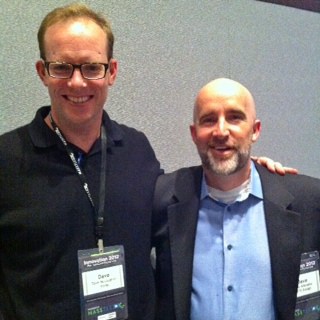Presenters:
Dave McLaughlin – Vsnap
Dave Wieneke – ISITEDesign
 |
| Dave McLaughlin of Vsnap and Dave Wieneke of ISITEDesign |
It’s
no longer just about products. It’s about the relationships with customers.
no longer just about products. It’s about the relationships with customers.
It’s
no longer all about what brands say about themselves. It’s about what customers say about brands.
no longer all about what brands say about themselves. It’s about what customers say about brands.
Raving,
happy fans are the holy grail of your success.
happy fans are the holy grail of your success.
Questions
to consider:
to consider:
· Does a strong, positive customer experience
trump paid exposure?
trump paid exposure?
· If you can give your customers an amazing
experience that not only keeps them coming back, but also inspires them to
share their positive brand story with others – isn’t that more valuable to
brand growth than traditional advertising?
experience that not only keeps them coming back, but also inspires them to
share their positive brand story with others – isn’t that more valuable to
brand growth than traditional advertising?
· How does your experience deliver on your
brand promise?
brand promise?
· First – do you know what your brand promise
is?
is?
· Second – does the experience you deliver live
up to that promise? Are you walking the walk, or just a lot of talk?
up to that promise? Are you walking the walk, or just a lot of talk?
For
example, Apple’s
promise:
example, Apple’s
promise:
· Connection between the aesthetic and the
engineering. The combination of the amazing visual experience and the elegant
functionality that lies beneath it – form and function. “It just works.” Emotional appeal – you’re cool. Value by
association.
engineering. The combination of the amazing visual experience and the elegant
functionality that lies beneath it – form and function. “It just works.” Emotional appeal – you’re cool. Value by
association.
Apple
owns customers’ hearts. Who else does? Other examples of brands with strong
brand promises: Starbucks, Google, etc.
owns customers’ hearts. Who else does? Other examples of brands with strong
brand promises: Starbucks, Google, etc.
Google’s
promise: “Every curiosity satisfied instantly”
promise: “Every curiosity satisfied instantly”
Bringing
humanity and emotional connection into the customer experience
humanity and emotional connection into the customer experience
The
web makes it a challenge to keep the emotional connection with customers. Apple
does it with big budgets and amazing creative. But customer experience also happens
down at the grass roots level. Customer experience is a living, breathing
element of your business – evolving with each interaction.
web makes it a challenge to keep the emotional connection with customers. Apple
does it with big budgets and amazing creative. But customer experience also happens
down at the grass roots level. Customer experience is a living, breathing
element of your business – evolving with each interaction.
To
create stronger connections and relationships, make sure you make use of your personality
and how you bring the human element to your interactions.
create stronger connections and relationships, make sure you make use of your personality
and how you bring the human element to your interactions.
To
find the worst website in the world, Google “our solutions.” Any site with this
term as one of their key terms is bound to be more focused on themselves than
on their customers.
find the worst website in the world, Google “our solutions.” Any site with this
term as one of their key terms is bound to be more focused on themselves than
on their customers.
What is
“Customer Experience?”
“Customer Experience?”
· Consistent values
· Consistent way of talking to customers
· “We believe…” … “Be part of this tribe if you
believe the same”
believe the same”
· You know what benefit you provide and for
whom
whom
· Unified experience for customers – always
feel like you’re talking to the same company, not a sales dept and a service
dept and a corporate office.
feel like you’re talking to the same company, not a sales dept and a service
dept and a corporate office.
A
good customer experience delivers customer loyalty, evangelism, retention, etc.
good customer experience delivers customer loyalty, evangelism, retention, etc.
To create a
great customer experience, you need a deep understanding of who you are serving
and their needs.
great customer experience, you need a deep understanding of who you are serving
and their needs.
You
need a really good picture of your customer – who they are, what they need, how
they interact with your brand at different touch points and how they feel about
those interactions. You need to think about them as individuals, not an
amorphous collective.
need a really good picture of your customer – who they are, what they need, how
they interact with your brand at different touch points and how they feel about
those interactions. You need to think about them as individuals, not an
amorphous collective.
Two
questions companies need to answer:
questions companies need to answer:
1. Who are you really? What do you stand for?2. How do we (company and customer) intersect?
Where do my products meet your needs? Where do our values align?
Where do my products meet your needs? Where do our values align?
It
can be a challenge to get a lot of people to do one simple thing, BUT – the
payoff is well worth the effort. Brands that stand for something – an ideal – typically
out perform brands that are missing this element. When you can associate your
brand with a value that customers identify with, they are willing to spend
more, talk more, and be more loyal and evangelical.
can be a challenge to get a lot of people to do one simple thing, BUT – the
payoff is well worth the effort. Brands that stand for something – an ideal – typically
out perform brands that are missing this element. When you can associate your
brand with a value that customers identify with, they are willing to spend
more, talk more, and be more loyal and evangelical.
Also,
having clearly defined and internally communicated values is
critical to delivering a unified customer experience. The people on the front
lines – the ones who interact with your customers – they need to buy into the
brand values and ethos. They need to represent and reflect that to your
customers at every interaction point.
having clearly defined and internally communicated values is
critical to delivering a unified customer experience. The people on the front
lines – the ones who interact with your customers – they need to buy into the
brand values and ethos. They need to represent and reflect that to your
customers at every interaction point.
Customer
experience influences on two levels:
experience influences on two levels:
·
Does the customer buy again, or not?
Does the customer buy again, or not?
·
Does the customer tell his or her friend, or
not?
Does the customer tell his or her friend, or
not?
(Subset: what
will you tell your friend – something positive or a warning to steer clear?
will you tell your friend – something positive or a warning to steer clear?
Make
people give a damn.
people give a damn.
Learn how to
recover from failure. Learn how to make customers happy, not just
explain to customers why they should be happy with what they want.
recover from failure. Learn how to make customers happy, not just
explain to customers why they should be happy with what they want.
We
have the most empowered customers in the history of business – swimming in
information, many options via quick clicks, opinions flow out via social
networks. Turning a negative situation into an opportunity to shine is one of
the best ways to improve customer loyalty.
have the most empowered customers in the history of business – swimming in
information, many options via quick clicks, opinions flow out via social
networks. Turning a negative situation into an opportunity to shine is one of
the best ways to improve customer loyalty.
Points of
information that influence purchase decisions (McKinsey):
information that influence purchase decisions (McKinsey):
Know
that only 1/3 of information touch points originate with the company and that
number actually goes down as people get deeper into the funnel. The closer
people get to purchase, the more outside opinions they will seek via peer and social
channels.
that only 1/3 of information touch points originate with the company and that
number actually goes down as people get deeper into the funnel. The closer
people get to purchase, the more outside opinions they will seek via peer and social
channels.
Are all
customers created equal?
customers created equal?
Are
you selective about your customers – only picking the ones you know you can
delight?
you selective about your customers – only picking the ones you know you can
delight?
You
should be.
should be.
If
you can narrow in on exactly whom you are serving, you can narrow in on what
needs they have and how you can serve them. You can then craft highly targeted solutions
that do delight and create rabid customers.
you can narrow in on exactly whom you are serving, you can narrow in on what
needs they have and how you can serve them. You can then craft highly targeted solutions
that do delight and create rabid customers.
Don’t focus
so much on your product.
so much on your product.
Focus
on the users and their needs and let that drive your products and services. If
you are meeting a real need, this kind of customer-centric focus will enable
you to get into and succeed in the market.
on the users and their needs and let that drive your products and services. If
you are meeting a real need, this kind of customer-centric focus will enable
you to get into and succeed in the market.
It’s
not enough to be functional. You also have to make your product easy and delightful
to use. It’s the difference between going out and getting merely edible food
and going out and getting a meal that makes you think you died and went to
heaven … and which you must tell your
friends about.
not enough to be functional. You also have to make your product easy and delightful
to use. It’s the difference between going out and getting merely edible food
and going out and getting a meal that makes you think you died and went to
heaven … and which you must tell your
friends about.
Build
rewards into the product:
rewards into the product:
·
Dropbox rewarding you with more storage space
Dropbox rewarding you with more storage space
·
LevelUp rewarding you with money in your
account
LevelUp rewarding you with money in your
account
·
Recognition for participation in brand
communities (either in fifteen minutes of fame or special access to information
or events, etc.)
Recognition for participation in brand
communities (either in fifteen minutes of fame or special access to information
or events, etc.)
Look
beyond the initial transaction to the lifetime value of the customer.
beyond the initial transaction to the lifetime value of the customer.
Mindset:
customer is the most valuable asset, not a combatant in a battle vs. sales or
customer service.
customer is the most valuable asset, not a combatant in a battle vs. sales or
customer service.
Take
responsibility for your business’ ecosystem – including all your partners and
your design.
responsibility for your business’ ecosystem – including all your partners and
your design.
Be
human. Be approachable. Be empathetic.
human. Be approachable. Be empathetic.
Follow up resource: Seven Truths for Designing Great Customer
Experiences by David Wieneke
Jamie Wallace helps clients create resonant brands, standout content, and loyalty-inspiring customer experiences at Suddenly Marketing. And she makes sure they have fun doing it.
Twitter: @suddenlyjamie



